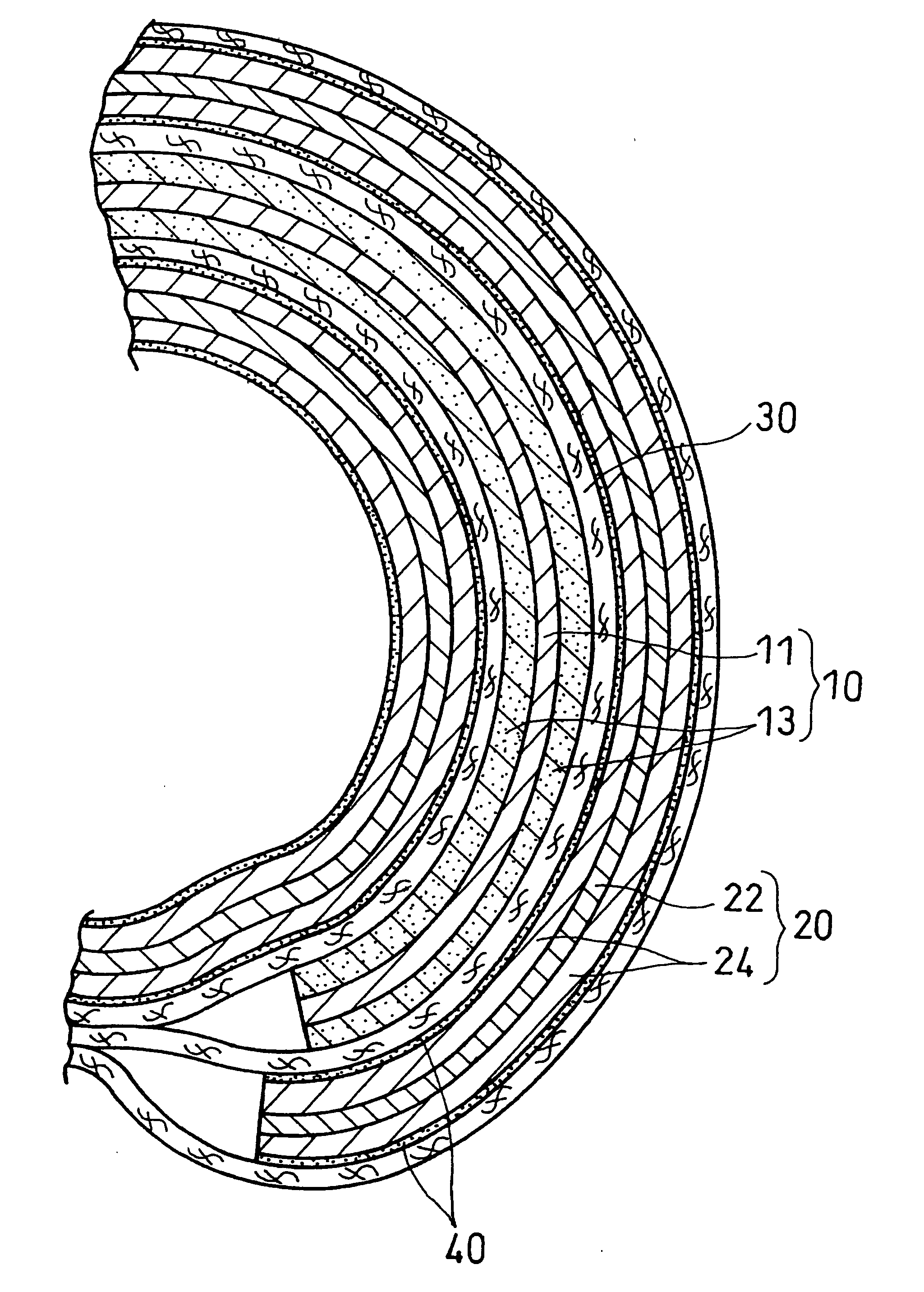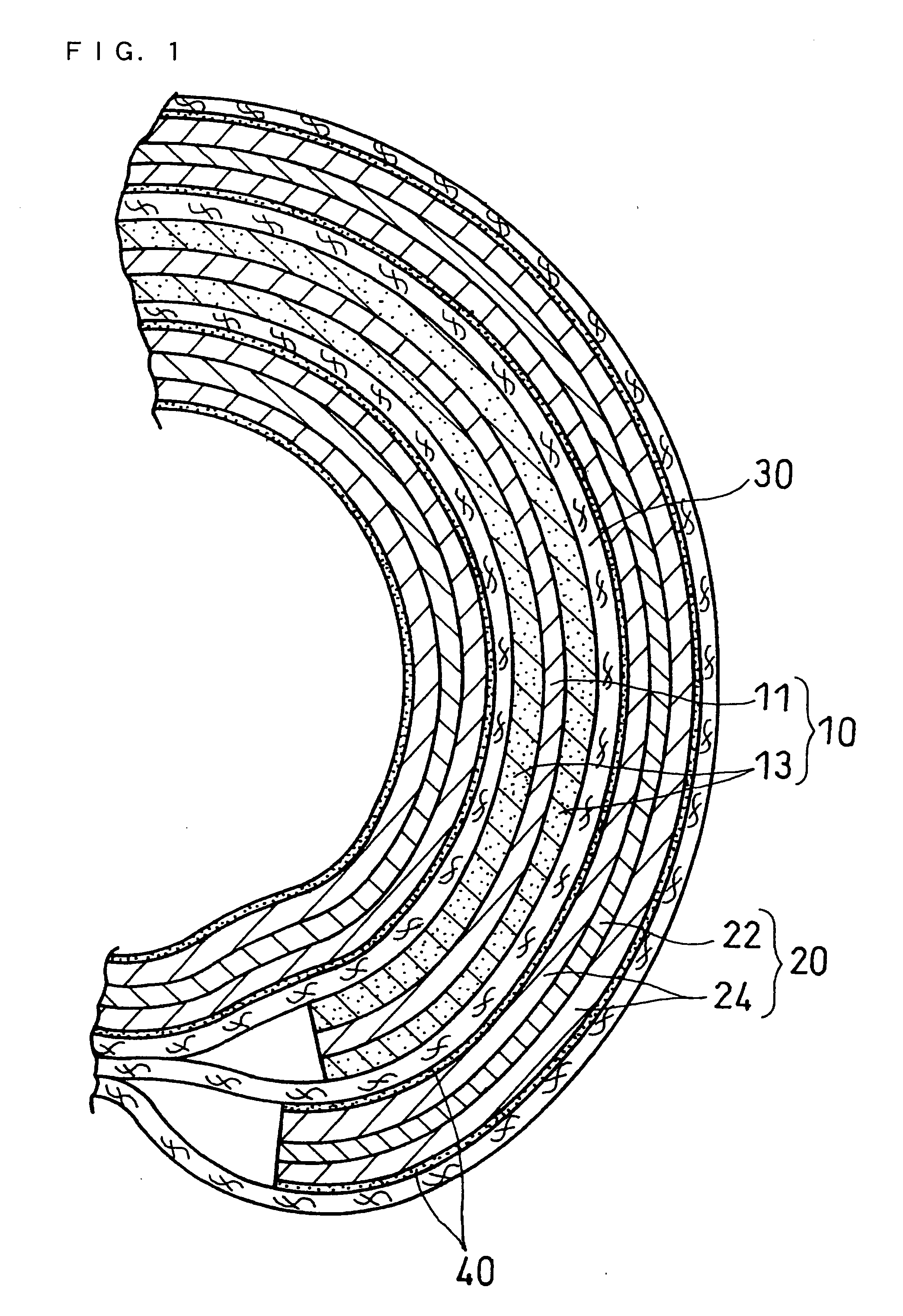Lithium Ion Secondary Battery And Method For Producing Negative Electrode Therefor
a secondary battery and negative electrode technology, applied in the direction of cell components, final product manufacturing, sustainable manufacturing/processing, etc., can solve the problems of excessive abnormally high temperature of the battery, and osmosis so as to improve the safety, reduce the separation of the electrode material mixture, and increase the adhesiveness of the porous film
- Summary
- Abstract
- Description
- Claims
- Application Information
AI Technical Summary
Benefits of technology
Problems solved by technology
Method used
Image
Examples
example 1
[0061] A negative electrode paste was made by stirring 2 kg of artificial graphite, 75 g of an aqueous dispersion of modified SBR (BM-400B manufactured by Zeon Corporation, a solid content of 40 wt %), 30 g of CMC, and an appropriate amount of water with a double-armed kneader. This paste was applied on both sides of copper foil with a thickness of 10 μm, dried, and rolled to give a total thickness of 180 μm. Negative electrode reels were thus obtained. The obtained negative electrode reels were dried in air at 110° C. for 6 hours.
[0062] Then, porous films were formed on the negative electrode reels by the method in below.
[0063] For porous film materials, an alumina powder with an average particle size of 0.5 μm, and four kinds of solutions of PVDF in NMP (#1120, #1320, #1710, and #7208 manufactured by Kureha Corporation) as resin binders were used. A concentration of 8.0 wt % was given to these solutions by appropriately diluting with NMP, and the viscosity was determined at 25° ...
example 2
[0074] A paste for a positive electrode material mixture was made by mixing 3 kg of lithium cobaltate, 1 kg of a solution of PVDF in NMP (#1320 manufactured by Kureha Corporation), 90 g of acetylene black, and an appropriate amount of NMP with a double-armed kneader. This paste was applied on both sides of aluminum foil with a thickness of 15 μm, dried, and rolled to give a total thickness of 160 μm. Positive electrode reels were thus obtained.
[0075] Then, porous films were formed on the obtained positive electrode reels by the following method.
[0076] That is, pastes 1A, 1B, 1C, and 1D for the porous film obtained in the same manner as Example 1 were applied on both sides of the positive electrode reels to give a thickness of 5 μm, and dried. Positive electrode reels 2A, 2B, 2C, and 2D with four types of porous films were thus obtained.
[0077] Further, the above pastes for the porous film were applied on one side of aluminum foil with a thickness of 15 μm and dried at 80° C. to gi...
example 3
[0080] On the negative electrode reels obtained in Example 1, porous films were formed by the method below.
[0081] For the porous film material, an alumina powder with an average particle size of 0.5 μm, and a solution of PVDF in NMP (#7208 manufactured by Kureha Corporation) as the resin binder were used. The PVDF used here was the same as the one used for 1D in Example 1. By using a double-armed kneader, the alumina powder in an amount of 950 g was mixed with an appropriate amount of the solution of PVDF in NMP (a concentration of 12 wt %), setting the amount of the PVDF to 0.5, 1.0, 1.5, 5, 10, and 15 parts by weight per 100 parts by weight of the alumina powder, thereby making pastes 3A, 3B, 3C, 3D, 3E, and 3F for the porous film, respectively.
[0082] Then, on both sides of the above negative electrode reels, the pastes 3A, 3B, 3C, 3D, 3E, and 3F for the porous film were applied to give a thickness of 5 μm and dried, thereby obtaining negative electrode reels 3A, 3B, 3C, 3D, 3E,...
PUM
| Property | Measurement | Unit |
|---|---|---|
| viscosity | aaaaa | aaaaa |
| temperature | aaaaa | aaaaa |
| temperature | aaaaa | aaaaa |
Abstract
Description
Claims
Application Information
 Login to View More
Login to View More - R&D
- Intellectual Property
- Life Sciences
- Materials
- Tech Scout
- Unparalleled Data Quality
- Higher Quality Content
- 60% Fewer Hallucinations
Browse by: Latest US Patents, China's latest patents, Technical Efficacy Thesaurus, Application Domain, Technology Topic, Popular Technical Reports.
© 2025 PatSnap. All rights reserved.Legal|Privacy policy|Modern Slavery Act Transparency Statement|Sitemap|About US| Contact US: help@patsnap.com



